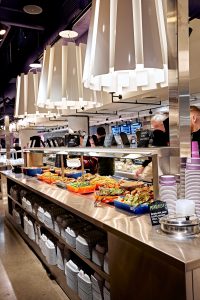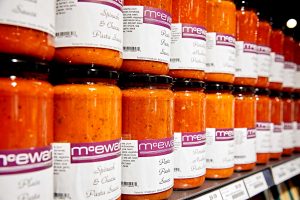Carefully curated
It’s 11:15 a.m. on a Friday in April, and the staff at the new McEwan Yonge & Bloor location in midtown Toronto are setting out prepared foods ahead of the lunch rush. They’ve literally just placed the final dish on the hot table when a group of customers in their 20s swoop in and fill up their plates.
By noon, the hot table and salad bar have steady lineups, and the 70-seat eating area is packed with lunchtime diners munching on everything from butter chicken to Roman-style pizza. Upbeat jazz music is playing over the speakers, and there’s a lively vibe in the 17,000-sq-ft grocery store—the third location under the banner—which opened for business in January.

“Our lunch crowd is amazing, we’re very lucky to have that,” says the store’s general manager, Eric McEwan—son of celebrity chef Mark McEwan, head of The McEwan Group (a food empire that includes the McEwan grocery stores, as well as renowned high-end restaurants in and around Toronto including Bymark, One and Fabbrica).
While lunch is currently the store’s busiest time, traffic is steady throughout the day. The store benefits from a high concentration of condos nearby—in fact, it occupies the basement level of a 75-story tower that’s predominantly residential—as well as a number of office buildings in the vicinity.
“
The store is all about being “chef driven” and offering high quality, whether in its grocery offerings or prepared foods. “Quality is No. 1,” says the elder McEwan. The selection of products and brands is “comprehensive, but it’s edited, so you don’t have big daunting aisles of grocery, which I’ve never related to well. Put it this way: I don’t need 100 different olive oils, but I do need 20 different olive oils,” he says. “It’s carefully curated, and carefully priced. So when people look at our grocery pricing, they say to me, ‘Wow, you’re surprisingly fair’ ...

A stroll through the aisles reveals packaged goods from Canadian companies like The Little Potato Company, Canards du Lac Brome, Chickapea, and Hippie Snacks; U.S. brands such as La Tourangelle, Wolfgang Puck, and Lundberg Family Farms; and international brands including Sharwood’s and Conservas de Cambados, to name a few. The store also offers a range of McEwan-branded, house-made items including sauces, salad dressing, rubs and pre-packaged prepared meals—although care is taken not to let McEwan-branded products overshadow the rest. “We don’t want to hide anyone’s brand behind ours,” says Eric McEwan. “We want people to be proud of their brand being in our store.”
Among the store’s impressive features: the aged meat locker, where nearly everything—steaks, whole ribs, whole striploins—is aged from 50 to 60 days; an extensive cheese selection featuring high-end local and international cheeses; and a bakery section that showcases house-baked items as well as breads, sweets and pastries from artisanal bakeries around the city.
There’s also a smoothie bar that offers eight smoothie options each day, and the popular Roman-style pizza outpost branded with the Fabbrica name (one of McEwan’s restaurants). “Our pizzas are all authentic Roman, with a 72-hour cure on the dough,” says Mark McEwan. And there’s a “gift” section featuring items such as Sugarfina candy from California, locally-made Mary Macleod shortbread, and Chapon chocolate from Paris.
The produce section has a focus on local wherever possible, and aims to help make home cooking more convenient. “Not only do we have whole yams or whole butternut squashes, but we also have portions that are cut and cleaned and even cubed for you, so they’re ready to go,” says Eric McEwan. “This is how we really gear ourselves toward the condo
But it’s the HMR offerings that are “the heart of the store,” says Mark McEwan. The hot table typically features 20 to 25 items prepared by in-store chefs, ranging from chicken biryani and paneer masala to stir-fried mixed peppers, steamed asparagus and chili flake garlic orecchiette. There are four soups offered daily, and a 45-ingredient salad bar. To allow customers the convenience to mix hot items and salads in one container, everything on the hot counter and the salad bar is the same price by weight.
There’s a panini station, as well as a carvery, which is next to the freshly prepared sandwich station. The P.E.I. prime rib from the carvery is a big favourite among regular customers, says Eric McEwan: “To be able to come and get hand-cut prime rib any day of the week, whether it be in a sandwich or to bring home, that has become one of our most popular items for sure.”
With interiors designed by Toronto’s Moncur Design Associates, the store’s underground locale helped shape the store’s overall design. “We’re in the basement, so light had to be a big factor in this store,” notes Eric McEwan. “As you can see, there are a lot of lights here.” That said, all the McEwan shops share certain visual similarities. “We try to stick to a lot of the same colour tones so concrete floors, whites, and aubergine, our purple colour—there are always splashes of that.”
Interestingly, the neighbourhood will also be home to Canada’s much-anticipated first Eataly location, expected to open later this year in the nearby Manu- life Centre. Neither the elder or younger McEwan, however, seems worried about the incoming competition. “I think it does nothing but rev up the neighbourhood,” says Mark McEwan.

As for future expansion, the celebrity chef says he’s “actively looking for key locations” for potential new stores. Meanwhile, at the new Yonge and Bloor location, the team is continuously working to get a better feel for what the clientele wants and making adjustments accordingly.
“The store is always in a state of morphing and changing and getting better,” says Mark McEwan, who stresses the importance of consistently raising the bar when it comes to customer service and quality. “We’re not the cheapest in the city, and when customers go home they should really enjoy eating what they’ve bought; it should be something they talk about. If it’s not, we didn’t do the right job.”
PHOTOGRAPHY BY MIKE FORD
This article appeared in Canadian Grocer's May issue.

